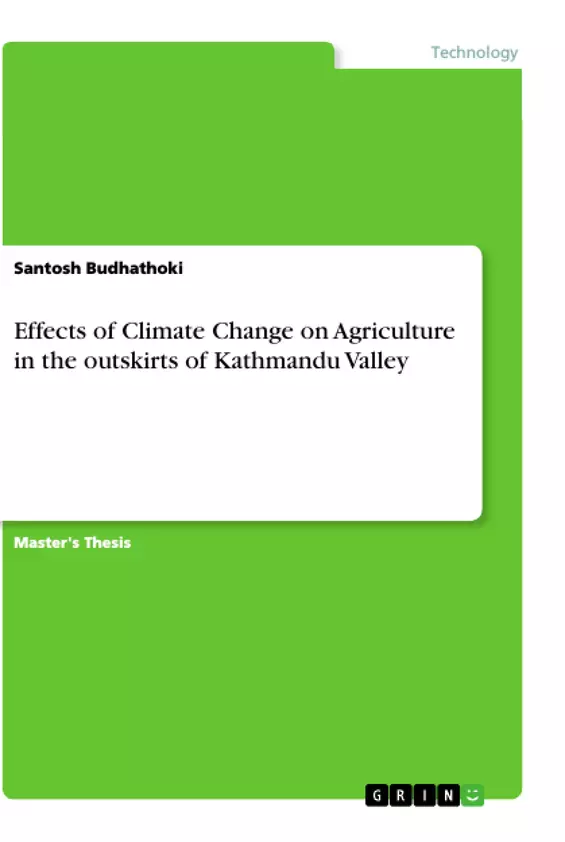The study focused on the observation of the effects of global warming and climate change on agriculture in the outskirts of Kathmandu valley. The objectives of the study were to identify the effects of climate change on agriculture in the surrounding hills of Kathmandu valley. The specific objectives of the study are: To study the effects of climate change on crop production in the research area. To find out shift of agricultural pattern in the research area. To suggest some mitigation and adaptation measures in the study area.
Nepal is one among the highest risk of climate change. It is divided into Mountain, Hill and Terai. It is divided into different land topography so enjoys wide range of climatic conditions form arid alpine to humid tropical climate. The average rise in temperature of Nepal is 0.06o C every year. The rate of increment is more in Himalayas than in Terai. Due to this, almost all the aspects of human life are affected one or the other ways. One of the mostly affected aspects is agriculture which is the major profession of Nepal. Nepal is an agriculture-based country where more than 65% of the population engages in agriculture for livelihood and agriculture shares about 33% of its GDP at current price and 35% at 2000/2001 constant price.
The study dealt about the implications of climate change in the outskirts of Kathmandu valley. The study was completed in Purano Naikap area which is one of the topographic representatives of the foothills of Kathmandu valley. Many cases of adverse effects of climate change were found in the study area such as untimely rain, infestation of alien grass species, infection of viral disease in tomato and paddy plants, invasion of different harmful insects like GabaroKiraand Green Caterpillar. The fields were left barren due to drought in the lands where it used to be wetland throughout the year. There is lack of irrigation facilities and lack of manpower for agriculture.
Inhaltsverzeichnis (Table of Contents)
- Abstract
- Chapter 1: Introduction
- 1.1 Background of the study
- 1.2 Statement of the problem
- 1.3 Objectives of the study
- 1.4 Research questions
- 1.5 Scope of the study
- 1.6 Significance of the study
- 1.7 Organization of the thesis
- Chapter 2: Literature Review
- 2.1 Climate change and its impacts
- 2.2 Impact of climate change on agriculture
- 2.3 Adaptation and mitigation strategies
- 2.4 Agriculture in Nepal
- 2.5 Agriculture in Kathmandu valley
- Chapter 3: Research Methodology
- 3.1 Study area
- 3.2 Sampling technique and sample size
- 3.3 Data collection tools and methods
- 3.4 Data analysis methods
- Chapter 4: Results and Discussion
- 4.1 Climate change impacts on agriculture in PuranoNaikap VDC
- 4.2 Adaptation strategies adopted by farmers
- 4.3 Socio-economic impacts of climate change on agriculture
- Chapter 5: Conclusion and Recommendations
Zielsetzung und Themenschwerpunkte (Objectives and Key Themes)
This thesis investigates the effects of climate change on agriculture in the outskirts of Kathmandu Valley, specifically focusing on the PuranoNaikap village. The research aims to understand the specific impacts of climate change on agricultural practices and yields, analyze the adaptation strategies employed by farmers, and explore the socio-economic consequences of these changes. The study utilizes a combination of quantitative and qualitative methodologies, including surveys, interviews, and field observations.
- Impact of climate change on agricultural practices and yields in the outskirts of Kathmandu Valley
- Adaptation strategies implemented by farmers to address climate change challenges
- Socio-economic consequences of climate change on agriculture and the livelihoods of farmers
- Analysis of climate change vulnerability and resilience in the study area
- Recommendations for effective climate change mitigation and adaptation strategies in the agricultural sector of the Kathmandu Valley
Zusammenfassung der Kapitel (Chapter Summaries)
Chapter 1: Introduction provides a comprehensive background of the study, highlighting the importance of understanding the effects of climate change on agriculture in Nepal, particularly in the Kathmandu Valley. This chapter clearly defines the research problem, outlines the objectives, research questions, scope, and significance of the study. It also presents the structure and organization of the thesis.
Chapter 2: Literature Review presents an extensive examination of existing research on climate change and its impacts, particularly focusing on the agricultural sector. The chapter delves into the effects of climate change on agriculture worldwide and in Nepal, specifically highlighting the situation in the Kathmandu Valley. This section also explores various adaptation and mitigation strategies implemented to address the challenges posed by climate change.
Chapter 3: Research Methodology elaborates on the research design and methods employed in the study. It outlines the study area, specifically focusing on PuranoNaikap village, and explains the sampling techniques and sample size used to collect data. This chapter also details the data collection tools and methods, including questionnaires, field visits, key informant interviews, and secondary data analysis, as well as the data analysis techniques employed.
Chapter 4: Results and Discussion presents the findings of the study, focusing on the specific impacts of climate change on agriculture in PuranoNaikap VDC. This chapter analyzes the observed changes in agricultural practices, crop yields, and the adaptation strategies adopted by farmers. It also discusses the socio-economic implications of climate change on the agricultural community.
Schlüsselwörter (Keywords)
Climate change, agriculture, Kathmandu Valley, PuranoNaikap VDC, adaptation strategies, socio-economic impacts, vulnerability, resilience, agricultural practices, crop yields, farmer livelihoods.
- Quote paper
- Santosh Budhathoki (Author), 2016, Effects of Climate Change on Agriculture in the outskirts of Kathmandu Valley, Munich, GRIN Verlag, https://www.grin.com/document/520094



